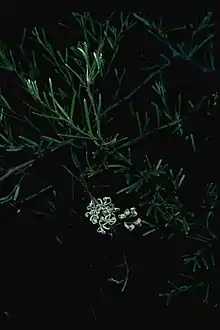| Grevillea costata | |
|---|---|
 | |
| In the Hunter Region Botanic Gardens | |
| Scientific classification | |
| Kingdom: | Plantae |
| Clade: | Tracheophytes |
| Clade: | Angiosperms |
| Clade: | Eudicots |
| Order: | Proteales |
| Family: | Proteaceae |
| Genus: | Grevillea |
| Species: | G. costata |
| Binomial name | |
| Grevillea costata | |
Grevillea costata is a species of flowering plant in the family Proteaceae and is endemic to the west of Western Australia. It is a spreading shrub with sharply-pointed, linear leaves and white flowers.
Description
Grevillea costata is a spreading shrub that typically grows to a height of 0.8–1.5 m (2 ft 7 in – 4 ft 11 in) and has many ridged, silky-hairy branchlets. Its leaves are linear, 15–45 mm (0.59–1.77 in) long and 0.8–1.3 mm (0.031–0.051 in) wide with the edges rolled under, enclosing all but the mid-vein. The flowers are arranged in groups of four to ten in leaf axils or on the ends of branchlets and are white, the pistil 7.0–9.5 mm (0.28–0.37 in) long with a white to cream-coloured, sometimes pink style. Flowering occurs from May to September and the fruit is an elliptic to oblong follicle 9.5–11 mm (0.37–0.43 in) long with prominent ridges.[3][4][5]
Taxonomy
Grevillea costata was first formally described in 1974 by Alex George in the journal Nuytsia from specimens collected by Charles Gardner near rocks in the Murchison River in 1931.[5][6] The specific epithet (costata) means "ribbed", referring to the fruit.[5][7]
Distribution and habitat
This grevillea grows in sand and among rocks in the river bed of the Murchison River in the Carnarvon, Geraldton Sandplains and Yalgoo biogeographic region of Western Australia.[3][4]
Conservation status
Grevillea costata is listed as Least Concern on the IUCN Red List of Threatened Species. Although its estimated extent of occurrence is relatively small at 6000km², its population is stable and faces no known major threats. Most of this species' range occurs in the protected area of Kalbarri National Park.[1]
It is also listed as "Priority Three" by the Government of Western Australia Department of Biodiversity, Conservation and Attractions,[4] meaning that it is poorly known and known from only a few locations but is not under imminent threat.[8]
See also
References
- 1 2 Monks, L.; Keighery, G. (2020). "Grevillea costata". IUCN Red List of Threatened Species. 2020: e.T112650868A113307826. doi:10.2305/IUCN.UK.2020-2.RLTS.T112650868A113307826.en. Retrieved 28 December 2023.
- ↑ "Grevillea costata". Australian Plant Census. Retrieved 8 March 2022.
- 1 2 "Grevillea costata". Australian Biological Resources Study, Department of Agriculture, Water and the Environment: Canberra. Retrieved 9 March 2022.
- 1 2 3 "Grevillea costata". FloraBase. Western Australian Government Department of Biodiversity, Conservation and Attractions.
- 1 2 3 George, Alex S. (1974). "Seven new species of Grevillea (Proteaceae) from Western Australia". Nuytsia. 1 (4): 370–371. Retrieved 9 March 2022.
- ↑ "Grevillea costata". APNI. Retrieved 9 March 2022.
- ↑ Sharr, Francis Aubi; George, Alex (2019). Western Australian Plant Names and Their Meanings (3rd ed.). Kardinya, WA: Four Gables Press. p. 171. ISBN 9780958034180.
- ↑ "Conservation codes for Western Australian Flora and Fauna" (PDF). Government of Western Australia Department of Parks and Wildlife. Retrieved 9 March 2022.

